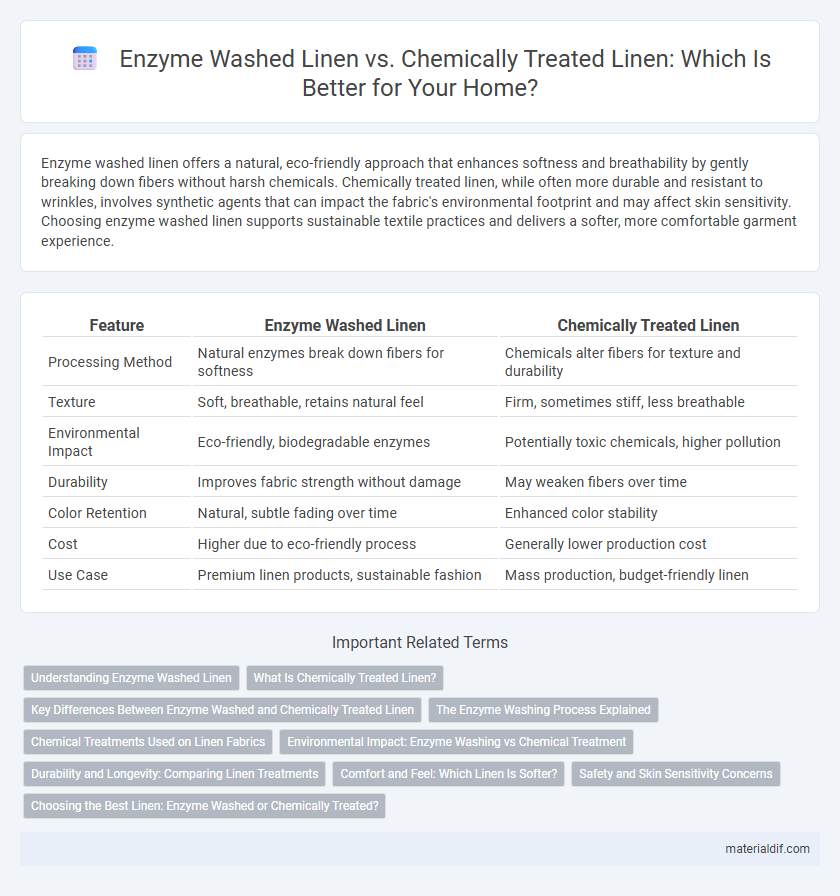Enzyme washed linen offers a natural, eco-friendly approach that enhances softness and breathability by gently breaking down fibers without harsh chemicals. Chemically treated linen, while often more durable and resistant to wrinkles, involves synthetic agents that can impact the fabric's environmental footprint and may affect skin sensitivity. Choosing enzyme washed linen supports sustainable textile practices and delivers a softer, more comfortable garment experience.
Table of Comparison
| Feature | Enzyme Washed Linen | Chemically Treated Linen |
|---|---|---|
| Processing Method | Natural enzymes break down fibers for softness | Chemicals alter fibers for texture and durability |
| Texture | Soft, breathable, retains natural feel | Firm, sometimes stiff, less breathable |
| Environmental Impact | Eco-friendly, biodegradable enzymes | Potentially toxic chemicals, higher pollution |
| Durability | Improves fabric strength without damage | May weaken fibers over time |
| Color Retention | Natural, subtle fading over time | Enhanced color stability |
| Cost | Higher due to eco-friendly process | Generally lower production cost |
| Use Case | Premium linen products, sustainable fashion | Mass production, budget-friendly linen |
Understanding Enzyme Washed Linen
Enzyme washed linen undergoes a natural treatment process using specific enzymes to soften fibers and enhance fabric texture without harsh chemicals, preserving the material's breathability and durability. This method improves the linen's absorbency and gives it a relaxed, worn-in feel while maintaining eco-friendly and skin-sensitive properties. In contrast to chemically treated linen, enzyme washing reduces environmental impact and minimizes potential fabric damage, making it a preferred choice for sustainable textile production.
What Is Chemically Treated Linen?
Chemically treated linen undergoes processes involving synthetic agents such as bleach, formaldehyde, or softening chemicals to enhance texture, color fastness, and wrinkle resistance. These treatments can alter the natural fibers, potentially affecting breathability and environmental sustainability compared to enzyme washed linen. Understanding the chemical compounds and methods used in linen treatment is crucial for assessing fabric durability, comfort, and ecological impact.
Key Differences Between Enzyme Washed and Chemically Treated Linen
Enzyme washed linen undergoes a natural, bio-based treatment using cellulase enzymes that gently soften fibers and enhance fabric durability without harsh chemicals, resulting in a breathable, eco-friendly textile. Chemically treated linen involves synthetic acids or alkalis to quickly remove impurities and stiffen the fabric, often compromising longevity and environmental sustainability. Key differences include enzyme washed linen's superior softness, enhanced moisture absorption, and reduced environmental impact compared to the harsher, less sustainable chemical treatments.
The Enzyme Washing Process Explained
The enzyme washing process for linen uses natural enzymes, typically cellulases, to gently break down fibers and remove surface fuzz, resulting in a softer texture without compromising fabric strength. This eco-friendly technique reduces the need for harsh chemicals, minimizing environmental impact while enhancing linen's breathability and durability. In contrast, chemically treated linen relies on synthetic agents that can weaken fibers and reduce fabric longevity.
Chemical Treatments Used on Linen Fabrics
Chemical treatments on linen fabrics often involve the use of bleaching agents, formaldehyde-based resins, and silicone softeners to enhance texture, durability, and wrinkle resistance. Enzyme washed linen utilizes natural enzymes like cellulase to gently break down fibers, resulting in a softer fabric without the harsh chemical residues. The enzymatic process preserves the linen's breathability and eco-friendly profile, contrasting with the potential environmental impact of synthetic chemical treatments.
Environmental Impact: Enzyme Washing vs Chemical Treatment
Enzyme-washed linen significantly reduces environmental impact by utilizing biodegradable enzymes that break down impurities without harmful emissions or water contamination. Chemical treatments often rely on synthetic agents and harsh solvents, leading to toxic waste and increased water pollution. Choosing enzyme washing promotes sustainable textile practices through lower energy consumption and reduced ecological footprint.
Durability and Longevity: Comparing Linen Treatments
Enzyme washed linen retains more of its natural fibers, enhancing durability and promoting longer fabric lifespan compared to chemically treated linen, which can weaken fibers over time due to harsh chemical processes. Enzyme treatment softens the fabric while preserving tensile strength, resulting in garments that withstand repeated use and washing without significant wear. Chemically treated linen often experiences faster fiber degradation, leading to reduced longevity and increased risk of fabric damage.
Comfort and Feel: Which Linen Is Softer?
Enzyme washed linen undergoes a natural process that breaks down fibers, resulting in a softer, smoother texture and enhanced breathability. Chemically treated linen often retains a stiffer feel due to synthetic agents that can reduce fabric softness and restrict airflow. Consumers seeking maximum comfort and a gentle touch typically prefer enzyme washed linen for its superior softness and natural hand feel.
Safety and Skin Sensitivity Concerns
Enzyme washed linen undergoes a natural biocatalytic process that reduces harsh chemical residues, making it safer and gentler for sensitive skin. Chemically treated linen often involves synthetic detergents and bleaching agents, which can cause irritation or allergic reactions in individuals with sensitive skin. Prioritizing enzyme washing enhances fabric softness and breathability while minimizing potential dermatological risks.
Choosing the Best Linen: Enzyme Washed or Chemically Treated?
Enzyme washed linen offers a softer texture and enhanced breathability by using natural enzymes to gently break down fibers, preserving the fabric's strength and eco-friendliness. Chemically treated linen undergoes processes involving synthetic agents that can improve wrinkle resistance and color retention but may compromise the material's sustainability and skin sensitivity. Choosing between enzyme washed and chemically treated linen depends on prioritizing softness and environmental impact versus durability and maintenance convenience.
Enzyme Washed Linen vs Chemically Treated Linen Infographic

 materialdif.com
materialdif.com